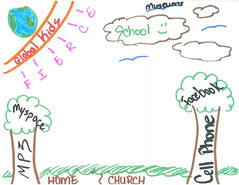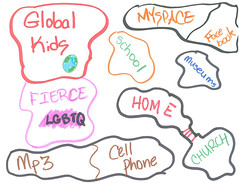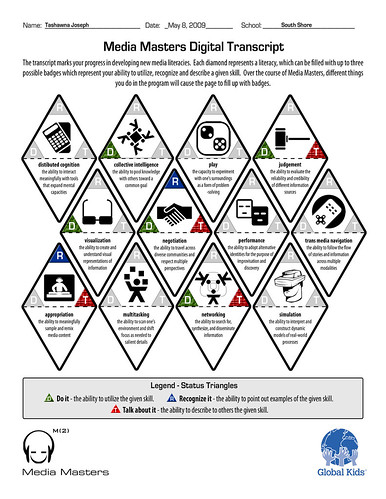
 Actually, this was her second drawing. She didn’t like her first because she was concerned it wasn’t original. The first one looked like this:
Actually, this was her second drawing. She didn’t like her first because she was concerned it wasn’t original. The first one looked like this:
 When I first viewed these I paid attention to how she chose to group certain nodes. I noticed the distinctions between informal learning institutions and the formal, between portable digital media and online.
Of course, Tashawna doesn’t walk around with a drawing of her learning network. I don’t think she’d even thought about all the places she learns before I’d asked her to draw these pictures. But when I did it was easy for her to list on a sheet of paper places like home and school. I had to push her, however, to list all of her portable media devices, web sites and after school programs. She wasn’t used to thinking about them all as sites of learning. After each one I asked her what she learned from that node:
When I first viewed these I paid attention to how she chose to group certain nodes. I noticed the distinctions between informal learning institutions and the formal, between portable digital media and online.
Of course, Tashawna doesn’t walk around with a drawing of her learning network. I don’t think she’d even thought about all the places she learns before I’d asked her to draw these pictures. But when I did it was easy for her to list on a sheet of paper places like home and school. I had to push her, however, to list all of her portable media devices, web sites and after school programs. She wasn’t used to thinking about them all as sites of learning. After each one I asked her what she learned from that node:
Me: What do you learn from texting on you cellphone?
Tashawna: How to spell bad! (laughs)
Me: What else?
Tashawna: How to use technology more effectively to communicate.
At the end of the process, as a representative of one of her learning nodes, I was left with a broader understanding of Tashawna’s network, of the resources she brings into our program, and where her learning with us might affect other sites of learning. From Tashawna’s perspective, I hope she began to think, perhaps for the first time, about herself as a participant within her network, as the final source creating meaning by synthesizing the collected learning, and as the one ultimately responsible for learning how to best design and navigate her network, now and in the future.
Digital Literacy Transcript
Even if Tashawna could fully articulate the learning she receives outside of the standard school curriculum, how can she communicate it to others, in a capacity more formal than a college essay? Last year, we worked with Henry Jenkins’ Project New Media Literacies to create something which might do just that: a Digital Literacy Transcript.
Henry Jenkins has identified and described the core literacies afforded by new media tools that are essential for full participation in our new digital age, such as Simulation, Negotiation, and Multitasking. Last year, Global Kids developed and implemented a curriculum that used social media to sharpen their literacies while assisting youth to understand how to think about them.
Below is Tashawna’s transcript by the end of the school year:
 The Transcript turns each literacy into a triangle-shaped badge. Each corner represents a different relationship with the literacy: I can recognize it, I can talk about it, and I can do it. At the beginning of our program each youth’s Transcript was blank. Over the course of the program youth watched their Transcript grow as badges were earned through completing social media projects in the program while also submitting existing work (fan fiction, podcasts, etc.) that demonstrated evidence of their existing competencies. For example, you might note that Tashawna completed her “negotiation” badge, was working on her “networking” badge, and never began “performance.”
The Transcript served as both a feedback mechanism to motivate and guide learning and an alternative transcript to show colleges or prospective employers about abilities which would otherwise go unrecognized.
Digital Literacy Portfolio
How could a college or potential employer viewing Tashawna’s Digital Literacy Transcript know that she actually learned the referenced skills? And for those new to the terms – which, to be frank, are most of us – what could she do to make these concepts clear and concrete? Enter the Digital Media Portfolio.
Each Portfolio is personally curated by youth like Tashawna to offer an audio and visual tour of their social media productions that highlights the literacies developed through each social media project. This stands in contrast to the Digital Transcript, which is official and controlled by Global Kids. Below is Tashawna’s:
The Transcript turns each literacy into a triangle-shaped badge. Each corner represents a different relationship with the literacy: I can recognize it, I can talk about it, and I can do it. At the beginning of our program each youth’s Transcript was blank. Over the course of the program youth watched their Transcript grow as badges were earned through completing social media projects in the program while also submitting existing work (fan fiction, podcasts, etc.) that demonstrated evidence of their existing competencies. For example, you might note that Tashawna completed her “negotiation” badge, was working on her “networking” badge, and never began “performance.”
The Transcript served as both a feedback mechanism to motivate and guide learning and an alternative transcript to show colleges or prospective employers about abilities which would otherwise go unrecognized.
Digital Literacy Portfolio
How could a college or potential employer viewing Tashawna’s Digital Literacy Transcript know that she actually learned the referenced skills? And for those new to the terms – which, to be frank, are most of us – what could she do to make these concepts clear and concrete? Enter the Digital Media Portfolio.
Each Portfolio is personally curated by youth like Tashawna to offer an audio and visual tour of their social media productions that highlights the literacies developed through each social media project. This stands in contrast to the Digital Transcript, which is official and controlled by Global Kids. Below is Tashawna’s: